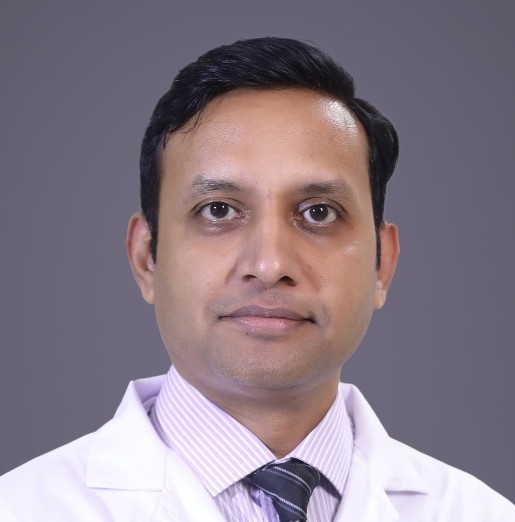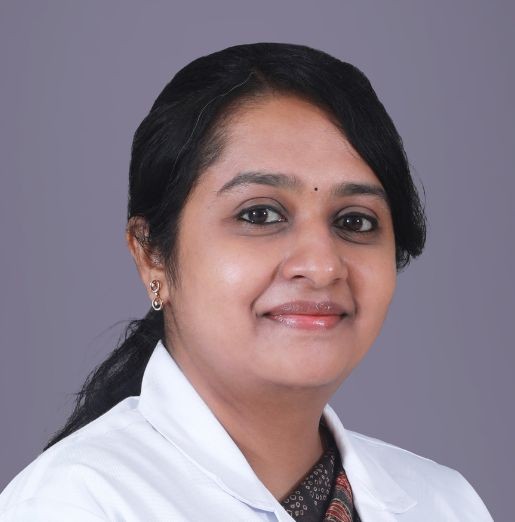Welcome to the Pulmonology Department at KIMS Hospitals in Electronic City. If you have anything pertaining to lung health we are here for you. Our pulmonologists work tirelessly so that we can give you the best care even if you have severe respiratory conditions, using modern and less invasive methods.
Experts in pulmonology, including interventional pulmonology, assist individuals in handling lung and airway problems. They focus on conditions linked to the chest often referred to as pulmonary or thoracic issues. They use advanced tools and procedures such as robotic bronchoscopy, pleuroscopy, thoracentesis, and thorough airway checks.
Pulmonology specialists collaborate with thoracic surgeons, oncologists, pathologists, and other required doctors. They create a treatment plan tailored to your needs, goals, test outcomes, and an accurate diagnosis.
Our center stands out as one of the few in India to provide advanced Interventional Pulmonology services. These help diagnose and treat airway, lung, and pleural conditions without requiring major surgical procedures.
A new approach to interventional pulmonology
Interventional Pulmonology focuses on solving issues in respiratory medicine by using modern bronchoscopic tools and imaging techniques. It helps identify and treat problems like lung cancer, chronic coughing, airway blockages, pleural effusion, interstitial lung disease, and recurring pneumothorax. It avoids open surgeries. Specialists in this field rely on advanced tools to detect and address these diseases. Robotic bronchoscopy stands out as a major innovation. This tool allows doctors to reach deep sections of the lung that were once out of reach. It helps them collect tissue from areas near or inside the airways that might carry cancer cells. This method shows a clear track record of reducing how long patients need to wait to go from diagnosis to treatment.
Conditions We Diagnose and Treat
- Airway Blocking or Narrowing
- Benign or malignant causes like tumours, scarring, or swelling can lead to airway stricture.
- Structural problems or tumours can press down on airways, making breathing hard.
- Some people are born with narrowed airways also called congenital airway stenosis.
- Weak windpipe walls known as tracheomalacia, can make the airway collapse.
- Cancers of the Lung and Airway
- Lung cancer
- Tumours in the chest area, including lung, mediastinal, or airway cancer
- Tumours inside the airways - endobronchial tumours
- Carcinoid growths
- Tumours in the pleura
- Conditions affecting the pleura and chest area
- Fluid buildup near the lungs (pleural effusion)
- Collapsed lung (pneumothorax)
- Scarring in the chest cavity (fibrosing mediastinitis)
- Inflammatory illnesses and infections
- Tuberculosis (both active and dormant forms)
- Breathing difficulties and recovery tied to COVID-19
- Pneumonia that keeps coming back
- Fungal infections and unusual infections in the lungs
- Sarcoidosis
- Granulomatosis with polyangiitis
- Relapsing polychondritis
- Lung or airway issues caused by amyloidosis
- Long-term breathing problems
- Chronic Obstructive Pulmonary Disease also known as COPD
- Pulmonary fibrosis and interstitial lung disease (ILD)
- Long-lasting respiratory failure, including cases needing ventilators
- Bleeding or unusual growths in the airways
- Coughing up blood (hemoptysis)
- Repeated respiratory papillomatosis, which includes wart-like growths in the airways
- Common lung and breathing concerns
- Persistent coughs that last beyond 8 weeks
- Shortness of breath without a clear reason
- Collapsed lung
- Unusual chest X-rays that need more testing
Our team of specialists focuses on diagnosing lung diseases. They can identify issues of both deep-seated and peripheral lung lesions. These techniques are crucial to detect lung cancer, tuberculosis, sarcoidosis, or ILD.
Main Diagnostic Techniques
- EBUS-TBNA (Endobronchial Ultrasound-guided Biopsy) – used to sample lymph nodes and chest masses
- Radial EBUS-Guided Biopsy – helps to check out nodules on the outer parts of the lungs.
- Cryobiopsy – gives better results than forceps biopsy when diagnosing interstitial lung diseases.
- Transbronchial Lung Biopsy (TBLB)
- Endobronchial Biopsy – used to examine mucosal layers or airway lesions seen
- Bronchoalveolar Lavage (BAL) – performed to find infections or inflammation in the lungs.
- Medical Thoracoscopy (Pleuroscopy) – helps diagnose pleural fluid buildup, pleural thickening, or cancer.
Tests, Procedures & Non-surgical Care at KIMS Hospitals, Electronic City
- Argon Plasma Coagulation (APC) – Contactless method to treat bleeding or remove tumours in the airways
- Balloon Dilation / Dilatation – Doctors place a balloon in narrow airways to widen them during airway stenosis.
- Bronchoalveolar Lavage (BAL) – Using saline to wash lung passages helps check for infections or lung inflammation.
- Bronchoscopy – Doctors use either a flexible or rigid scope to inspect the airways.
- Electromagnetic Navigational Bronchoscopy – This technique uses guidance technology to access hard-to-reach spots in the lungs.
- Endobronchial Cryotherapy & Biopsy – Freezing methods remove tumours, collect tissue samples, or clear granulation tissue.
- Endobronchial Laser Treatment – High-energy lasers are used to reduce or get rid of blockages in airways.
- Endobronchial Ultrasound-Guided Biopsy (EBUS) – Doctors collect tissue samples from lung masses or lymph nodes by using ultrasound images.
- Endoscopic Lung Volume Reduction – A less invasive option to help COPD patients breathe better.
- Electrocautery & Debulking – Specialists remove tumours or growths blocking airways.
- Foreign Body Removal – Medical teams extract objects stuck in airways for both kids and adults.
- Microknife Treatment of Strictures – Doctors cut to open up airways that are too narrow.
- Placement of Endobronchial Valves – Used to treat stubborn air leaks or lungs that have collapsed.
- Airway Stent Placement – Doctors use silicone or metal stents to hold open airways that are narrow or have collapsed.
- Pleuroscopy (Medical Thoracoscopy) – This involves using a less invasive method to examine the pleural space to diagnose or take a biopsy.
- Pleurodesis with Talc – This process is done to treat pleural effusion that keeps coming back.
- Indwelling Pleural Catheter (IPC) Placement – Physicians place this catheter to manage pleural effusions over time.
- Chest Tube Insertion & Pleural Fluid Drainage – A tube is inserted to drain fluid from around the lungs.
- Radial Endobronchial Ultrasound Biopsy – This is used to take samples from tiny lung nodules in hard-to-reach areas.
- Rigid bronchoscopy – Used to address major airway blockages or tumours.
- Robotic-assisted bronchoscopy – Enables precise sampling of small or difficult-to-access lung nodules.
- Thoracentesis – Uses a needle to remove fluid that surrounds the lungs.
- Tracheostomy Placement & Management – Your doctor will make a hole in the neck through which you can breathe.
- Transbronchial Cryobiopsy – A cutting-edge method when your doctor takes a sample of your lung tissue to diagnose interstitial lung diseases.
Doctors adjust each procedure based on the patient's condition, prioritising both safety and comfort.

